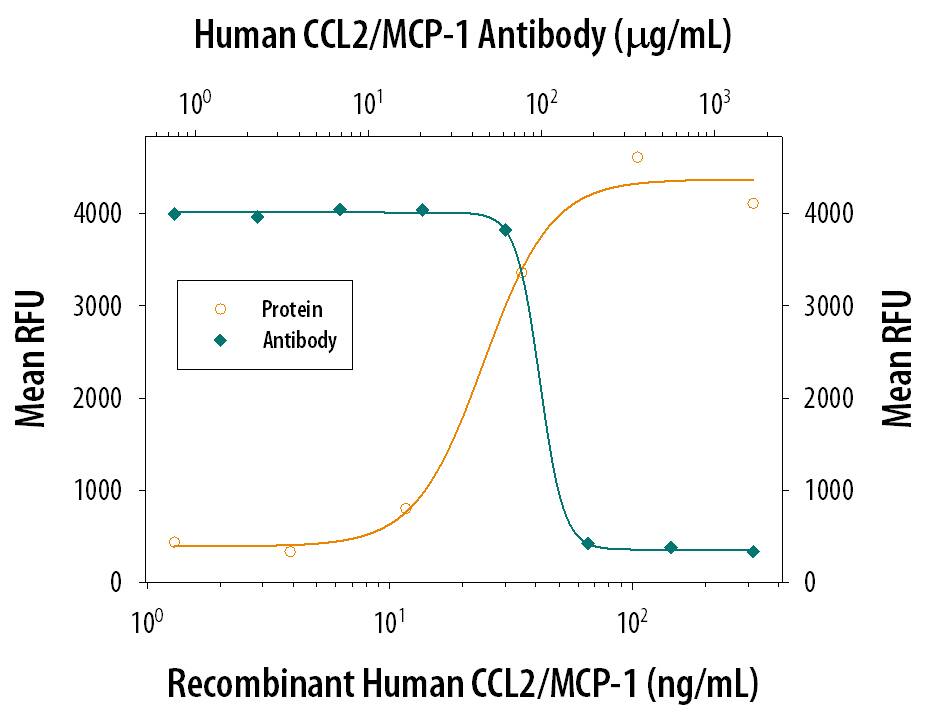Human CCL2/JE/MCP-1 Antibody
R&D Systems, part of Bio-Techne | Catalog # AB-279-NA

Key Product Details
Species Reactivity
Validated:
Cited:
Applications
Validated:
Cited:
Label
Antibody Source
Product Specifications
Immunogen
Gln24-Thr99
Accession # P13500
Specificity
Clonality
Host
Isotype
Endotoxin Level
Scientific Data Images for Human CCL2/JE/MCP-1 Antibody
Chemotaxis Induced by CCL2/MCP‑1 and Neutral-ization by Human CCL2/ MCP‑1 Antibody.
Recombinant Human CCL2/ MCP-1 (Catalog # 279-MC) chemoattracts BaF3 mouse pro-B cell line transfected with human CCR2A in a dose-dependent manner (orange line). The amount of cells that migrated through to the lower chemotaxis chamber was measured by Resazurin (Catalog # AR002). Chemotaxis elicited by Recombinant Human CCL2/ MCP-1 (0.1 µg/mL) is neutralized (green line) by increasing concentrations of Goat Anti-Human CCL2/MCP-1 Polyclonal Antibody (Catalog # AB-279-NA). The ND50 is typically 50-100 µg/mL.Applications for Human CCL2/JE/MCP-1 Antibody
Western Blot
Sample: Recombinant Human CCL2/JE/MCP-1 (Catalog # 279-MC)
Neutralization
Formulation, Preparation, and Storage
Purification
Reconstitution
Formulation
Shipping
Stability & Storage
- 12 months from date of receipt, -20 to -70 °C as supplied.
- 1 month, 2 to 8 °C under sterile conditions after reconstitution.
- 6 months, -20 to -70 °C under sterile conditions after reconstitution.
Background: CCL2/JE/MCP-1
CCL2, also called monocyte chemotactic protein-1 (MCP-1) or JE, is a member of the C-C or beta chemokine family that is best known as a chemotactic agent for mononuclear cells (1, 2). Human CCL2 cDNA encodes a 99 amino acid (aa) precursor protein with a 23 aa signal peptide and a 76 aa mature protein (2). Removal of the first 5 aa of the mature protein, including the N-terminal pyrrolidone carboxylic acid-modified glutamine, occurs naturally by metalloproteinase cleavage and downregulates activity but not receptor binding (3). CCL2 may form multiple bands from 8.7‑13.5 kDa on SDS-PAGE due to non-covalent dimerization and variable carbohydrate content (3). Mature human CCL2 shares 78 - 79% aa identity with canine, porcine and equine CCL2, while mouse and rat express a form of CCL2 that is extended by 49 aa and shares only ~56% aa identity within the common region. Human CCL2 can, however, induce a response in murine cells (4). Fibroblasts, glioma cells, smooth muscle cells, endothelial cells, lymphocytes and mononuclear phagocytes can produce CCL2 either constitutively or upon mitogenic stimulation, but monocytes and macrophages appear to be the major source (1, 2). In addition to its chemotactic activity, CCL2 induces enzyme and cytokine release by monocytes, NK cells and lymphocytes, and histamine release by basophils that express its receptor, CCR2 (2). Additionally, it promotes Th2 polarization in CD4+ T cells (5). CCL2-mediated recruitment of monocytes to sites of inflammation is proposed to play a role in the pathology of atherosclerosis, multiple sclerosis and allergic asthma (6, 7).
References
- Yoshimura, T. et al. (1989) FEBS Lett. 244:487.
- Deshmane, S.L. et al. (2009) J. Interferon Cytokine Res. 29:313.
- Proost, P. et al. (1998) J. Immunol. 160:4034.
- Van Riper, G. et al. (1993) J. Exp. Med. 177:851.
- Luther, S.A. and J.G. Cyster (2001) Nat. Immunol. 2:102.
- Daly, C. et al. (2003) Microcirculation 10:247.
- Aukrust, P. et al. (2008) Arterioscler. Thromb. Vasc. Biol. 28:1909.
Alternate Names
Gene Symbol
UniProt
Additional CCL2/JE/MCP-1 Products
Product Documents for Human CCL2/JE/MCP-1 Antibody
Product Specific Notices for Human CCL2/JE/MCP-1 Antibody
For research use only
